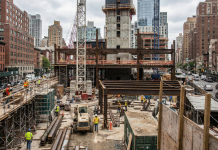Millions of empty containers leave American ports each year due to trade imbalances.
Most sit in costly storage yards. But when I visited Atlanta, I found developers turning this waste into profit.
The Melody Project Breaks Speed Records
Walking through The Melody’s construction site, I watched crews install what looked like giant Lego blocks. Developer Mike Benko used shipping containers to create studio apartments in just four months from conception to occupancy.
“We cut construction costs significantly compared to traditional methods,” Benko told me. “Container units cost substantially less per square foot than stick-frame apartments.”
Normal apartment construction takes 12-18 months.
I watched this speed advantage firsthand. While site crews poured foundations, Falcon Structures modified containers 50 miles away. Each container arrived with plumbing rough-in, electrical systems, and spray foam insulation already installed. “It’s like delivering finished rooms,” site supervisor Carlos Martinez explained as a crane lowered another unit into place.
The Real Environmental Numbers
But speed wasn’t the only advantage I discovered. Container buildings produce significantly less carbon than traditional construction methods.
Each 40-foot container recycles several tons of steel. The fabrication process requires minimal electricity for complete modification work.
The construction industry accounts for roughly one-third of global emissions. Building materials like cement and steel are major contributors to worldwide emissions.
Using old containers turns waste into buildings without making new steel. The sourcing process proved simpler than expected. Falcon Structures buys containers for several thousand dollars each from shipping lines retiring older units. “We look for containers with minimal rust and good structural integrity,” procurement manager Sarah Chen explained. “One-trip containers cost more but need less prep work.”
Real-World Challenges I Uncovered
My investigation revealed significant hurdles beyond permits. Georgia allows container buildings but requires normal electrical, plumbing, and structural work. Atlanta has tougher zoning rules that classify containers as “manufactured housing” in some districts. Insulation proved critical. “Containers are steel boxes that conduct heat like crazy,” HVAC contractor Jim Walsh told me. “We use 3-inch spray foam on walls and 6-inch on roofs. Otherwise, you’re living in an oven.”
Rural areas have cheaper land and easier zoning. Cities have higher utility costs and permit delays that kill the speed advantage. Ventilation requires extra attention. Standard containers have no windows, so builders must cut openings and install proper air circulation. “We add three windows and a ventilation fan to each unit,” Benko said. “It’s not optional—it’s survival.”
Containers last decades with maintenance. They’re built for ocean weather, so they handle building use well. I interviewed three Melody residents about living quality. “It’s surprisingly quiet,” said tenant Maria Rodriguez. “The steel walls block sound better than my old apartment’s drywall.” However, she noted that temperature control took adjustment—”You learn to use curtains and fans strategically.”
Beyond Atlanta: The Bigger Picture
Container building hit billions in market value and continues growing rapidly as housing shortages grow. I found similar projects across Georgia. In Savannah, architect Tom Bradley converted containers into a 12-unit affordable housing complex for substantially less than comparable traditional construction. Near Athens, container classrooms cost significantly less per square foot than conventional modular buildings.
Builders nationwide are watching Georgia projects. “When lumber jumped dramatically in 2021, containers stayed stable,” noted Atlanta contractor Dave Wilson. Speed, green benefits, and cost control matter when material prices swing wildly.
Container building shows how to adapt. As environmental rules get stricter and costs rise, using old materials might become normal—especially for affordable housing where every dollar counts.
What This Means for Your Next Project
Atlanta proves containers work fast and green. After investigating multiple projects, I see three key opportunities:
For affordable housing developers: Container construction offers significant cost savings with faster delivery—crucial when housing shortages demand speed.
For rural builders: Easier permitting and lower land costs make containers especially viable outside cities. Consider them for workforce housing or temporary facilities.
For commercial developers: Container offices, retail, and hospitality projects can test market demand quickly with lower upfront investment.
The question isn’t whether containers work—it’s whether you’ll use them before your competition does. Start with a small project to learn the process, then scale up as you master the unique requirements.
Container construction won’t replace traditional building, but it’s becoming a legitimate tool for specific applications. The Atlanta projects prove that when done right, containers deliver both environmental benefits and bottom-line results.








